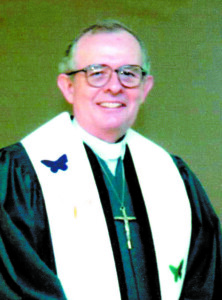Independent Thought — The Circle of Life

By Rev. Bob Plaisted
Columnist
“There’s far too much to take in here, more to find than can ever be found. But the sun rolling high through the sapphire sky, keeps great and small on the endless round, in the circle of life, the circle of life.” Those lyrics are from “The Lion King,” written by Tim Rice, and set to music by Elton John. It’s a great musical, a great song, and it inspired this column.
Western civilization, dominated by the traditions of Christianity, generally has theorized that time and life flow in a straight line from the past toward the future. Most thinking on this side of the globe stems from that assumption. We look at life as a kind of relay race. Each generation lays down the baton at death, to be taken up by the next generation, which then runs the next leg of the race. The bigger question, of how time ends, has been answered with doctrines of afterlife, heaven and hell, in which time ceases to exist and is replaced by a timeless eternity.
Fewer than half of Earth’s people see things that way. The farther east we go, the more likely people are to see life, not as a straight line, but as an infinite series of circles and cycles. One doesn’t need to practice an Eastern religion to think that linear time might not be the whole story. If you doubt that, re-read “The Circle of Life,” composed by two Englishmen.
It’s not that the idea of cycles and circles is foreign to Christianity. Ecclesiastes, chapter one, says, in part: “The sun rises, the sun sets, then hurries back to rise again…All rivers flow to the sea, yet the sea is never full. The rivers return to where they began,” (Ecclesiastes 1:5,7).
Life operates in cycles. We’re born; we grow; we mature; we find our place in life, we get older; we decline, we die, completing a full circle of life. I don’t envision life either as a straight line, or a series of repetitive cycles. Instead, I see life as a screw-thread, drilling down through layer after layer, ever deeper into reality. I won’t try to prove that, but the theory might help explain how we bumbled our way into our present, unholy mess.
Example: Recently, I was working to assemble a small item, using the few simple hand tools I still possess. At one point, a common machine screw refused to be driven. No matter how many times I lined it up, it just turned round and round without drawing the parts together. After much delay and frustration, I finally made it work. In the midst of trembling hands, sweating and muttering, it occurred to me that humans can act somewhat like that recalcitrant screw.
No matter how firmly, that rational people try to drill down into the deepest layers of reality, knowledge and wisdom — hoping that their efforts might produce a kinder, wiser world — there always seems to be a reactionary minority who refuse go any deeper. They believe that what happened in the past must continue in the present. They might call themselves “conservatives,” but they’re just recalcitrant screws.
Why are millions of Americans today preparing to vote for a dictator, 250 years after we left kings/dictators behind? Why do judges in 2024, (scientific facts about human reproduction be damned), cite religious dogma from the 1600s or even ancient Israel 2,500 years ago? It’s not God’s will that frozen embryos now are legally considered children in Alabama. It’s theirs.
This could explain the constant whiplash between progress and obstruction in human history. Reactionary people resist new knowledge, simply because it challenges dogma they learned as children. They’re terrified of the unknown, so they turn round and round, resisting fresh information with all the stubbornness of a balky machine screw. They’re dead weight, obstructing the circle of life. But, the circling and cycling of life can be delayed only so long. When those recalcitrant screws finally take hold, a whole new circle of life can begin.
Rev. Robert Plaisted is a retired United Methodist clergyman, formerly of Bridgton and Bath, now residing in Auburn.

